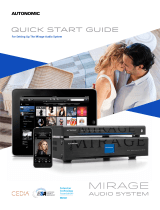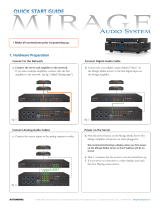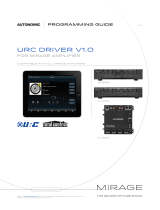
Autonomic Programming Guide | 2 of 18
MirageAudioSystem.com
Vocabulary
MCP Driver
MMS control program driver or MCP, also known as the central driver, is the
conductor of the MMS drivers. It makes communication between the MMS and
processor appear similar to an MAS setup. According to the server, the MCP driver
isanAutonomic amplier, which allows communication with other control 4
compatibleampliers.
Instance Driver
The Instance driver represents and controlsa single output on the MMS. One
driver is needed per output on theMMS.
• A Series Instance: Instance driver for MMS-5A and MMS-2A servers
• eSeries instance: Instance driver for MMS-1e, MMS-3e and MMS-5e streamers.
Favorites Driver
The Favorites driver will display and grant access to all saved favorites on the MMS.
Favorites can also be linked to actions in the programing section under a specic
room, they will appear as a broadcast audio items when browsing for media.
Service Drivers
Service driversare drivers for all the embedded streaming services offered on the MMS.
Amp Driver
Provides user control over power, volume, source selection and zone selection for
any Autonomic amplier.
MCP Actions
Congure MMS
This action informs the MCP server of the available outputs based on the drivers
available in the Control4 program.
Refresh Driver State
The MCP server makes every effort to maintain up to date information on all of
its bound Service drivers, but this can be forced using this action.
Update Rooms
The MCP driver requires a current list of Autonomic services for each room in the
project. It is important to press this button after adding or removing rooms and
after completing initial setup.
























